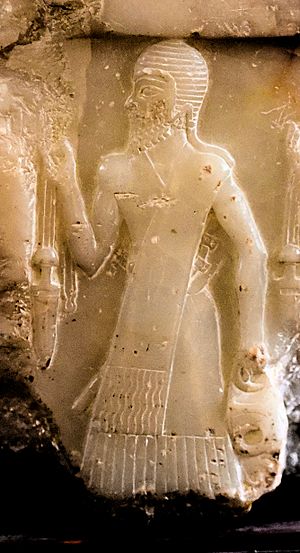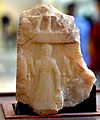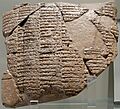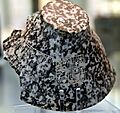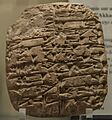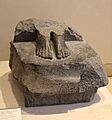Naram-Sin of Akkad facts for kids
Quick facts for kids Naram-Sin𒀭𒈾𒊏𒄠𒀭𒂗𒍪 |
|
|---|---|
|
|
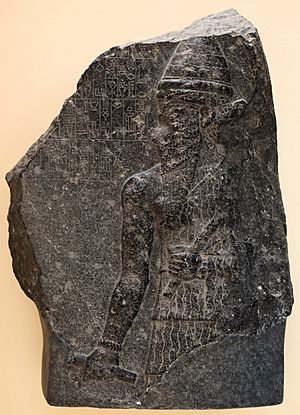
Portrait of Naram-Sin
|
|
| King of the Akkadian Empire | |
| Reign | c. 2254 – 2218 BC |
| Predecessor | Manishtushu |
| Successor | Sharkalisharri |
| Issue | Shar-Kali-Sharri |
| Dynasty | Dynasty of Akkad |
| Father | Manishtushu |
Naram-Sin was a powerful ruler of the Akkadian Empire. He reigned from about 2254 to 2218 BC. He was the grandson of the famous King Sargon of Akkad.
Under Naram-Sin, the Akkadian Empire became very strong and grew to its largest size. He was the first king in Mesopotamia to say he was a god. He called himself "God of Akkad." He also claimed the titles "King of the Four Quarters" and "King of the Universe." This meant he saw himself as a ruler over a vast area.
Contents
Biography of Naram-Sin
Naram-Sin was the son of Manishtushu. This made him the nephew of King Rimush and the grandson of Sargon. His aunt was En-hedu-ana, a very important high priestess.
Naram-Sin's Reign
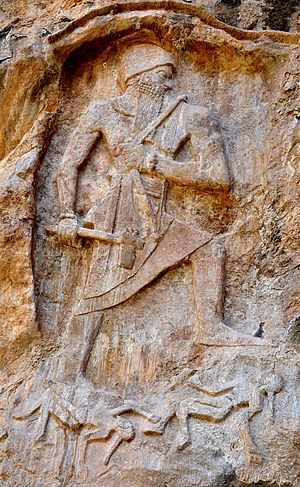
Naram-Sin was a great military leader. He defeated many enemies, including Manium of Magan and various mountain tribes. These tribes lived in the Zagros, Taurus, and Amanus Mountains.
He expanded his empire all the way to the Mediterranean Sea and Armenia. His famous "Victory Stele" shows him winning against Satuni, the leader of the Lullubi people.
Ancient records say he ruled for 56 years. We know about at least 20 years of his reign from special "year-names." These names often describe his military victories. For example, one year was called "the Year when Naram-Sin was victorious against Simurrum."
Naram-Sin also built many important temples. He built them in cities like Akkad, Nippur, and Zabala. He also set up new government centers in Nagar and Nineveh. At one point, a large part of his empire rebelled, led by Iphur-Kis from the city of Kish. Naram-Sin quickly put down this rebellion.
Sumerian Kings Join the Empire
Some Sumerian rulers became part of Naram-Sin's empire. For example, Lugal-ushumgal, the governor of Lagash, was a "servant" of Naram-Sin. This meant he was loyal to the Akkadian king.
This shows that Lugal-ushumgal worked with the Akkadian Empire. Another ruler, Meskigal of Adab, also cooperated. Later, as the Akkadian Empire became weaker, some of these rulers, like Puzer-Mama of Lagash, became independent again.
Control Over Elam
The region of Elam was under the control of the Akkadian Empire even before Naram-Sin. King Khita of Elam likely signed a peace treaty with Naram-Sin. This treaty said: "The enemy of Naram-Sin is my enemy, the friend of Naram-Sin is my friend."
This agreement helped Naram-Sin keep peace on his eastern border. It allowed him to focus on threats from the Gutians. The treaty might have also meant that Khita sent Elamite soldiers to help Naram-Sin. It's also thought that Khita's daughter married the Akkadian king.
Naram-Sin had a lot of power in the city of Susa in Elam. He built temples there and put up inscriptions with his name. The Akkadian language even started to replace Elamite in official documents. Akkadian governors were also in charge of Elam during Naram-Sin's rule.
Conquering Armanum and Ebla
Naram-Sin also led campaigns to areas like Cilicia and Anatolia. This is suggested by a special stone carving called the Nasiriyah stele. This stele shows Akkadian soldiers leading captives. The items they carry, like a metal pot, look like they came from Anatolia. This suggests Naram-Sin's armies reached far into those lands.
The Curse of Akkad Myth
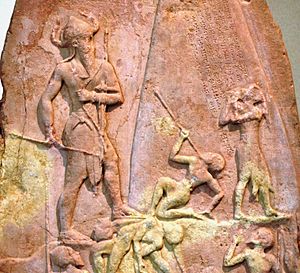
There's an old Mesopotamian story called "The Curse of Akkad." It explains why the great city of Akkad was destroyed. This myth was written hundreds of years after Naram-Sin lived. It tries to explain why the Gutians were able to conquer Sumer.
The story says that Naram-Sin made the chief god Enlil angry. He did this by taking treasures from Enlil's temple, the Ekur, in the city of Nippur. Because of this, Enlil sent the Gutians down from the mountains. They brought terrible problems like disease, hunger, and death to Mesopotamia.
Food became very expensive. To stop this destruction, eight other gods decided that Akkad had to be destroyed. This would save the rest of Sumer. The story ends by describing Akkad's sad fate, just as the gods had cursed it.
Gutian Attacks
The attacks by the Gutians were indeed very destructive. It's not clear how much damage they caused across all of Sumer. At one point, the Gutians even set up their capital in the city of Adab.
When Naram-Sin died around 2219 BC, he may have left his empire mostly whole to his son, Shar-Kali-Sharri. However, the Gutians remained a strong force for over 100 years. They were later replaced by the Ur III state.
Naram-Sin's Victory Stele
Naram-Sin's Victory Stele is a famous stone carving. It shows him as a god-king, wearing a horned helmet. He is shown climbing a mountain, with his soldiers below him. His enemies, the defeated Lullubi people and their king Satuni, are being trampled.
The stele was broken at the top when it was stolen by the Elamite king Shutruk-Nakhunte around 1200 BC. Even so, it clearly shows Naram-Sin's pride, glory, and his claim to be divine. The stele is about 6 feet 7 inches tall and made of pinkish sandstone. It was found in Susa and is now in the Louvre Museum.
Naram-Sin's Children
Naram-Sin had several children. His most famous son was his successor, Shar-Kali-Sharri. Another son, Nabi-Ulmash, was a governor.
Archaeologists found a special seal that belonged to Tar'am-Agade. She was a daughter of Naram-Sin who was not known before. She might have married a ruler of Urkesh. Another son, Sharatigubishin, was a governor. His daughter Tuṭṭanabšum was the high priestess of Enlil in Nippur. This was a very important religious job. She was also made a god, which was very rare for a woman or someone who wasn't a king.
Early Archaeology by Nabonidus
Around 550 BC, King Nabonidus found and studied a special foundation deposit from Naram-Sin's time. Some people call Nabonidus the first archaeologist. He led the first excavations to find these ancient deposits. These included deposits from temples in Sippar and a sanctuary Naram-Sin built in Harran.
Nabonidus also had these ancient buildings restored. He was also the first person to try and date an archaeological object. He tried to figure out when Naram-Sin's temple was built. His estimate was off by about 1,500 years, but it was still an amazing effort for his time!
See also
 In Spanish: Naram-Sin para niños
In Spanish: Naram-Sin para niños
- Bassetki Statue
- History of Mesopotamia
- Sumerian king list
- House of Ashes
Images for kids
-
Naram-Sin stele, inscription of Naram-Sin in the Akkadian language. The name Naram-Sin (𒀭𒈾𒊏𒄠𒀭𒂗𒍪) appears vertically in the upper right box.
-
Treaty of alliance between Naram-Sin and Khita of Susa, king of Awan, about 2250 BC, Susa, Louvre Museum.
-
Stele of the Akkadian king Naram-Sin. The "-ra-am" and "-sin" parts of the name "Naram-Sin" are in the broken top right corner. Istanbul Archaeological Museum.
-
Alabaster vase in the name of "Naran-Sin, King of the four regions" ('𒀭𒈾𒊏𒄠𒀭𒂗𒍪 𒈗 𒆠𒅁𒊏𒁴 𒅈𒁀𒅎
DNa-ra-am DSîn lugal ki-ibratim arbaim), limestone, about 2250 BC. Louvre Museum AO 74. -
"Naran-Sin, King of the four regions" ('𒀭𒈾𒊏𒄠𒀭𒂗𒍪 𒈗 𒆠𒅁𒊏𒁴 𒅈𒁀𒅎
DNa-ra-am DSîn lugal ki-ibratim arbaim), limestone, about 2250 BC. Louvre Museum AO 74. -
This bronze head was thought to be Sargon, but now many believe it is his grandson Naram-Sin.
-
Fragment of a stone bowl with an inscription of Naram-Sin, and a second inscription by Shulgi (upside down). Ur, Iraq. British Museum.



